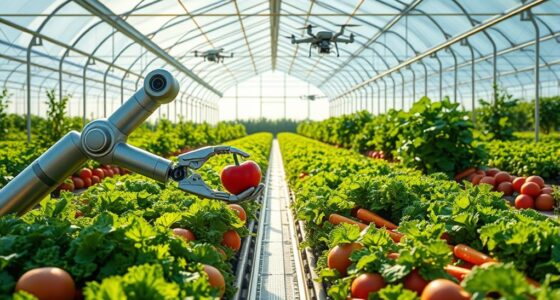To survive off-grid for months or more, you need to secure reliable water sources, store and preserve food using techniques like dehydration and fermentation, and choose crops that thrive locally. Build a durable shelter with good insulation and ventilation, and set up renewable power systems like solar with proper storage. Manage waste responsibly, keep essential supplies stocked, and implement security measures. Forming a supportive community boosts resilience. Keep exploring these areas to guarantee your long-term survival plan stays on track.
Key Takeaways
- Secure and regularly test reliable water sources; implement filtration, purification, and conservation strategies for sustainability.
- Cultivate perennial crops and preserve surplus food through dehydration, fermentation, and proper storage techniques.
- Design durable, energy-efficient shelter with proper insulation, ventilation, and sustainable materials suited to the environment.
- Establish dependable power systems using solar panels, batteries, and system monitoring for continuous energy supply.
- Develop sanitation and waste management systems, including composting toilets and greywater recycling, to maintain hygiene and environmental health.
Assessing and Securing Water Sources
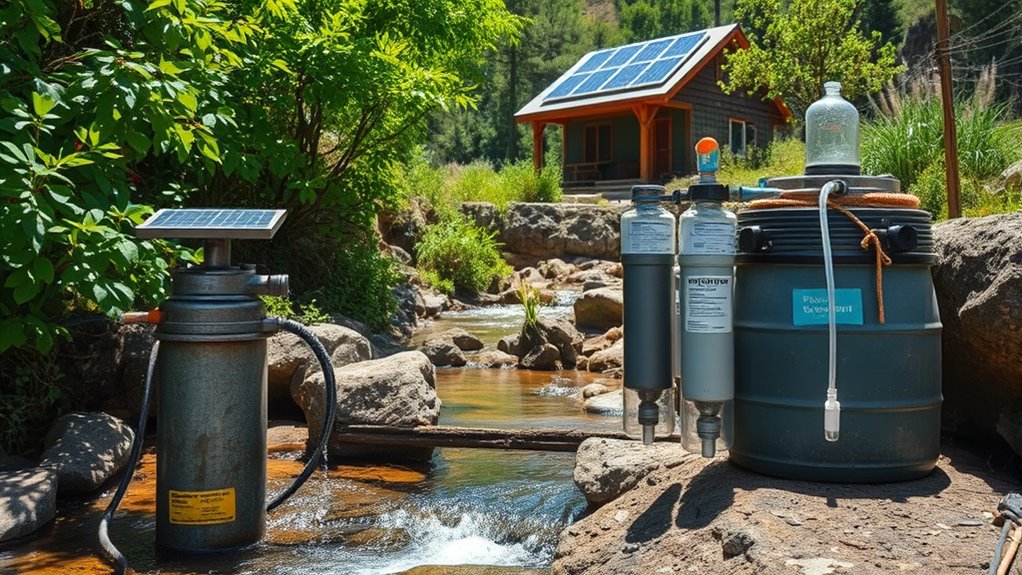
Have you evaluated the water sources available in your area and taken steps to secure them? Identifying reliable water sources is *vital* for long-term survival. Once you’ve pinpointed potential sources like wells, streams, or rain catchments, focus on water filtration to *guarantee* safety. Installing filters or purification systems helps remove contaminants, making water safe to drink. Remember, water conservation is equally important; use only what you need and implement strategies such as collecting rainwater or limiting unnecessary use. Protect your water sources from contamination by establishing barriers or covering storage containers. Regularly test water quality to detect any pollutants early. By *gauging* your water options and applying filtration and conservation techniques, you enhance your resilience and *guarantee* a sustainable water supply during extended emergencies.
Growing and Preserving Food Supplies
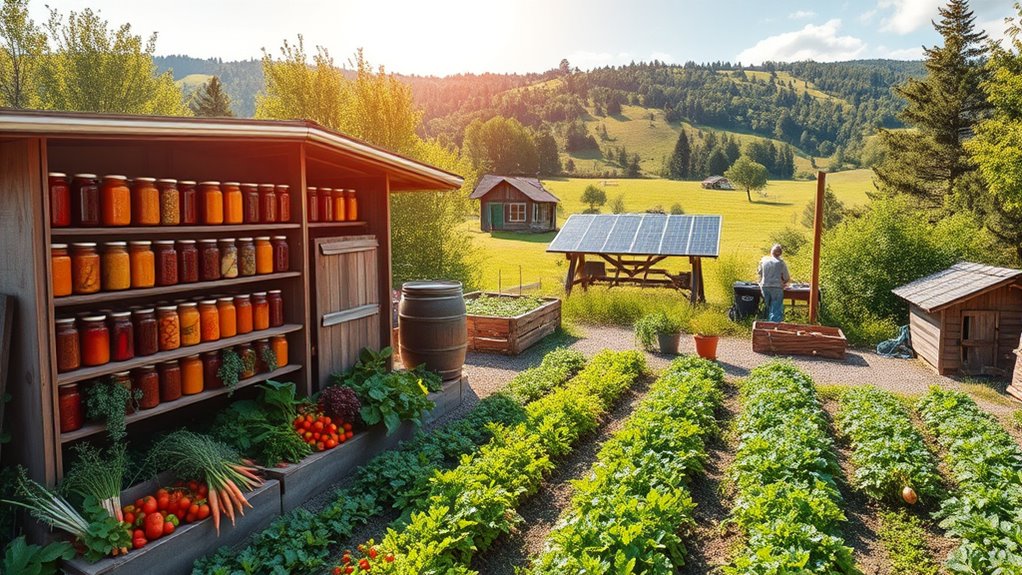
To guarantee your food supply lasts, you need to choose sustainable crops that grow well in your environment. Mastering preservation techniques will keep your harvest fresh and safe for the long term. Planning your seasonal food needs helps you maximize storage and reduce waste throughout the year. Additionally, understanding cost and budgeting considerations can help you allocate resources effectively for long-term food security. Incorporating organic seed cultivation methods not only improves soil health and crop quality but also supports environmentally friendly practices that sustain your food sources over time. Embracing breakfast delivery trends can provide fresh, nutritious options during times when growing and preserving food may be challenging.
Sustainable Crop Selection
Choosing the right crops is essential for building a resilient food supply that can withstand environmental challenges and changing conditions. Focus on perennial crops, which grow year after year with minimal replanting, reducing labor and soil disturbance. These crops help maintain soil fertility by preventing erosion and promoting nutrient cycling. Selecting hardy, adaptable perennials guarantees a steady food source during long-term off-grid living. Consider crops like berries, asparagus, and certain herbs, which thrive with less maintenance and improve soil health over time. By prioritizing perennial varieties, you create a sustainable system that minimizes effort and maximizes yield, ensuring your food supply remains robust and reliable through fluctuating seasons and environmental stresses. Incorporating soil health practices further enhances the resilience of your crop system, promoting long-term productivity and sustainability. Additionally, choosing dog-friendly plants can support companionship and security around your homestead, especially if you plan to have dogs or other animals as part of your off-grid lifestyle. Including a variety of native plants can also improve the adaptability of your garden to local climate conditions and pests, further strengthening your food security.
Preservation Techniques Mastery
Building a resilient food system involves not only selecting sustainable crops but also mastering effective preservation techniques. You need methods to extend shelf life and retain nutrients, especially in off-grid scenarios. Food dehydration is a reliable technique, removing moisture to prevent spoilage. Proper dehydration techniques ensure maximum nutrient retention and prevent mold growth. Additionally, understanding food preservation methods can inspire innovative storage and preservation ideas that integrate seamlessly into self-sufficient living. To succeed, consider these key methods:
- Food dehydration—drying fruits, vegetables, and herbs to store long-term. Proper dehydration techniques ensure maximum nutrient retention and prevent mold growth.
- Fermentation techniques—canning vegetables or fermenting grains for nutritious, preserved options. Understanding fermentation also enhances gut health through probiotic-rich foods.
- Proper storage conditions—keeping preserved foods in cool, dry, and dark environments to maximize longevity. Maintaining appropriate storage environments is crucial for preventing spoilage and ensuring food safety. Additionally, controlling humidity levels can significantly improve food preservation outcomes.
Seasonal Food Planning
Since seasons influence the availability of fresh produce, planning your food supplies around the agricultural calendar guarantees a steady food supply year-round. Seasonal food planning helps you determine when to plant and harvest crops, ensuring you maximize your yield. Incorporate crop rotation into your strategy to maintain soil fertility and reduce pest buildup, which is essential for sustainable off-grid living. By rotating crops carefully, you can prevent soil depletion and improve crop health, making your food supply more reliable. Preserving excess produce through canning, drying, or fermenting ensures you have nutritious food during off-seasons. Staying organized with your planting schedule and preservation methods enables you to adapt to seasonal changes, securing your long-term survival while maintaining a balanced diet off-grid. Additionally, selecting low light office plants such as snake plants and pothos can improve indoor air quality and provide a touch of greenery during darker months. Incorporating seasonal planting schedules can further optimize your crop yields and ensure a continuous food supply throughout the year. Planning ahead by understanding market fluctuations can also help you better manage your food stockpile and preserve your resources efficiently. Using data analytics tools can assist in forecasting crop yields and optimal planting times, further enhancing your off-grid food security.
Designing an Efficient Shelter for Longevity

Designing an efficient shelter for longevity requires careful consideration of materials, layout, and environmental factors to guarantee durability and sustainability. Choose high-quality insulation materials to maintain stable indoor temperatures and reduce energy needs. Proper ventilation systems are essential for air quality, moisture control, and preventing mold. Focus on a compact, well-ventilated layout that minimizes exposed surfaces and maximizes thermal efficiency. Prioritize durable, local materials resistant to weather and pests to extend lifespan. Incorporate strategic sealing around windows and doors to prevent drafts. Ensure the shelter can adapt to seasonal changes while maintaining structural integrity. Additionally, implementing maintenance practices can significantly prolong the lifespan of your shelter by addressing issues before they escalate. Regular inspections and timely repairs are crucial for shelter longevity and overall durability. Incorporating natural elements such as vegetation and natural lighting can further enhance insulation and reduce environmental impact. Considering AI-driven safety monitoring can help identify potential vulnerabilities early, ensuring continuous shelter integrity. Understanding the importance of empathy in planning can help anticipate potential issues and improve overall resilience. By balancing insulation, ventilation, and robust construction, you create a sustainable, resilient living space that supports long-term off-grid survival.
Establishing Reliable Power Generation and Storage
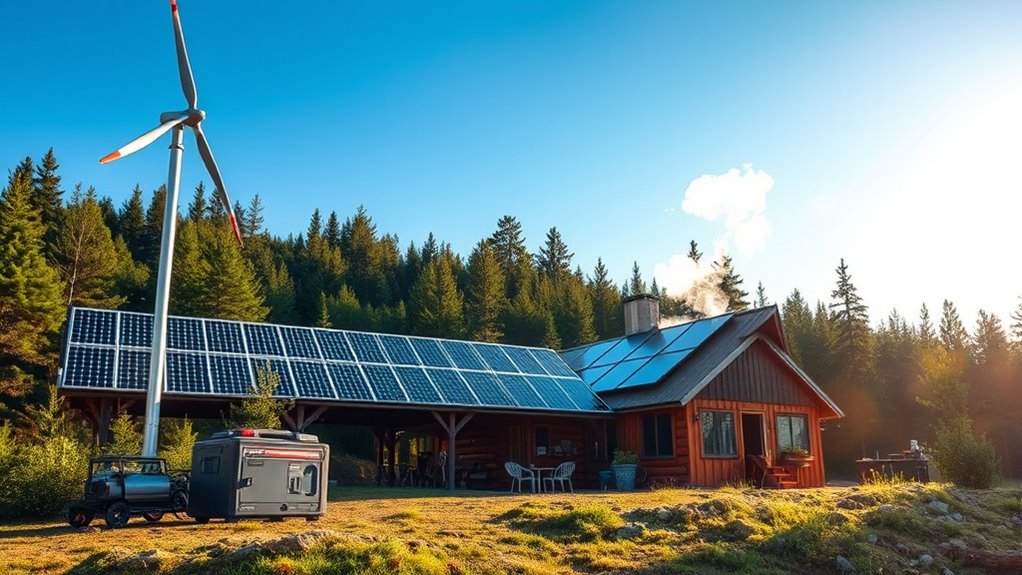
Establishing dependable power generation and storage is crucial for long-term survival, especially when grid access isn’t available. Solar panels are your best option for generating clean, renewable energy consistently. Choose high-efficiency panels suited to your environment to maximize energy production. Pair them with quality battery storage systems to store excess power generated during sunny days. This stored energy will power essential devices when sunlight isn’t available, such as at night or on cloudy days. Regular maintenance of your solar panels ensures prime performance, while proper battery care prolongs lifespan. Incorporating lifestyle considerations such as setting up a comfortable and organized workspace can help maintain motivation and mental well-being during extended off-grid periods. Additionally, understanding the importance of attention in maintaining your energy system’s optimal operation can help prevent overlooked issues that might compromise your setup. Developing wall organization strategies for your equipment and tools can streamline maintenance tasks and keep your setup efficient. Utilizing system monitoring tools can provide real-time data to identify potential issues early and optimize energy use. Conducting routine system testing can further ensure your energy system remains reliable over time. By investing in reliable solar power and robust storage solutions, you create a sustainable energy system that supports your off-grid lifestyle long-term, reducing dependence on external sources and increasing your chances of survival.
Creating Waste Management and Sanitation Systems

Creating effective waste management and sanitation systems is essential for maintaining health and safety in your long-term survival setup. Proper systems prevent contamination and promote sustainability. Consider installing composting toilets, which reduce water use and turn waste into usable compost. Incorporate greywater systems to recycle wastewater from sinks and showers for irrigation, minimizing waste. To guarantee efficiency, focus on these key elements:
Effective waste management safeguards health and sustainability in your long-term survival setup.
- Proper Ventilation and Sealing of Composting Toilets
- Diverting Greywater to Filtration or Irrigation Areas
- Regular Monitoring and Maintenance of Waste Systems
Developing Skills for Self-Reliance and Maintenance
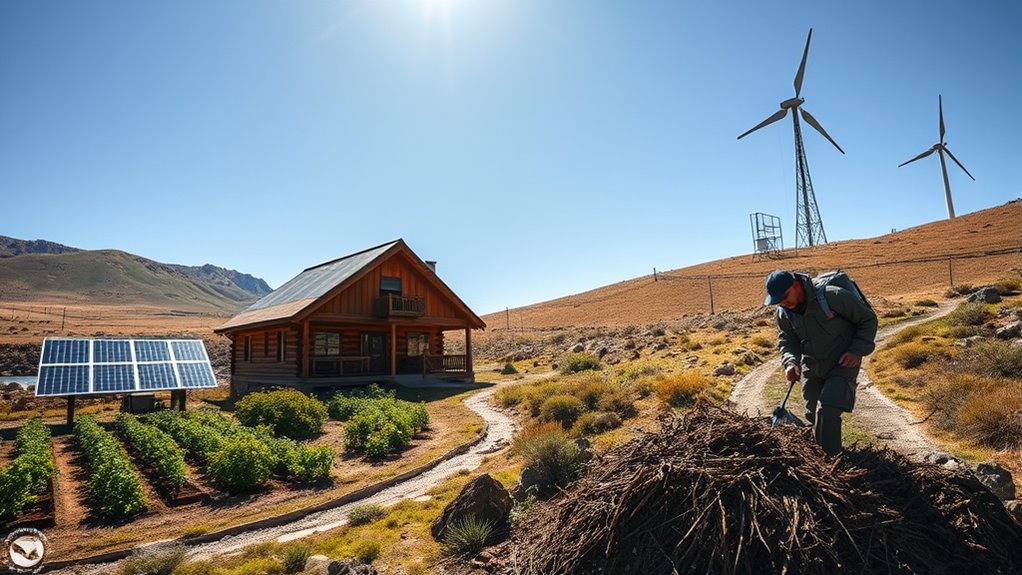
Building a strong foundation of skills is essential for guaranteeing your self-reliance and ability to maintain your survival setup over the long term. You should learn how to harness solar energy efficiently, including setting up and troubleshooting solar panels and batteries. Developing expertise in tool maintenance keeps your equipment reliable and extends its lifespan, minimizing downtime. Practice repairing and sharpening tools so you’re prepared for any situation. Understanding basic electrical work related to solar systems helps you troubleshoot issues quickly. Additionally, sharpening your skills in resource management and problem-solving ensures you can adapt as conditions change. These skills empower you to stay self-sufficient, reduce dependence on external help, and sustain your off-grid life for months or more.
Stockpiling and Managing Essential Supplies
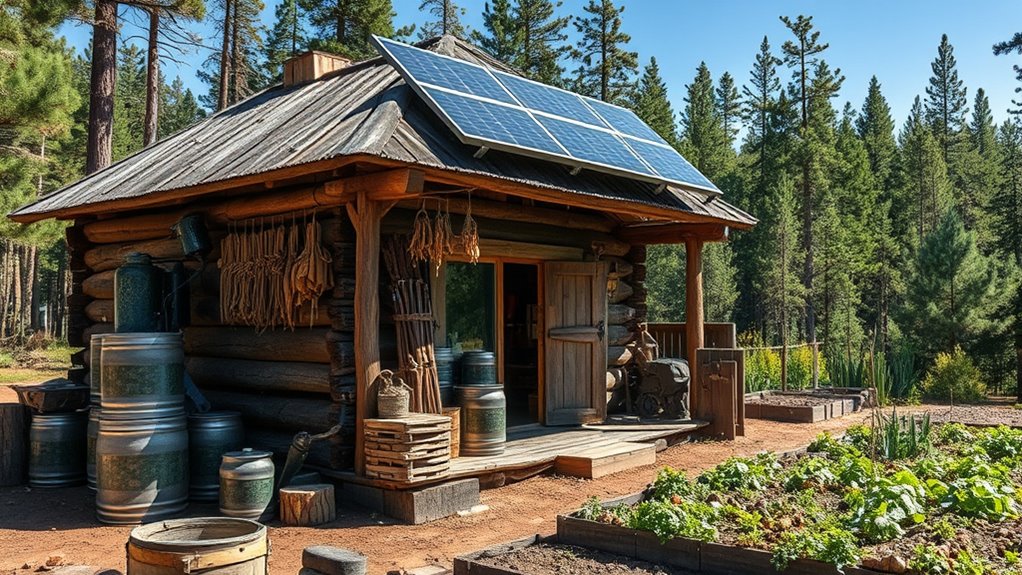
Effective stockpiling and management of essential supplies are crucial for ensuring your long-term survival. You need a well-organized system to track quantities, expiration dates, and storage conditions. This helps prevent shortages and waste, especially when relying on renewable energy sources to power your supplies. Prioritize items like water, food, and medical supplies, and consider redundancy for critical items.
Key strategies include:
- Stockpile enough supplies to last several months, updating inventory regularly.
- Establish emergency communication plans that don’t rely solely on electricity.
- Rotate stored items to maintain freshness and readiness, ensuring your supplies remain usable over time.
Implementing Safety and Security Measures
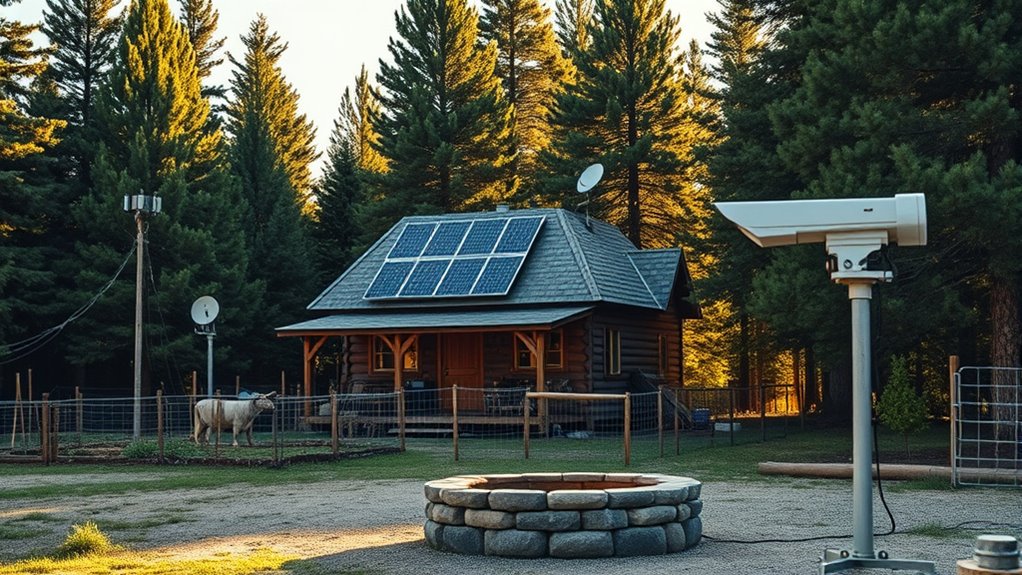
To protect yourself and your supplies, you need a sturdy shelter foundation that can withstand potential threats. Implementing effective defense strategies and surveillance systems helps you stay aware of any intruders or hazards. By securing these safety measures, you create a safer environment for long-term survival.
Secure Shelter Foundations
Ensuring your shelter has a secure foundation is essential for long-term safety and stability. A solid foundation prevents shifting, settling, and potential collapse. To achieve this, focus on foundation stability through proper ground leveling, ensuring the terrain is even and supportive.
Consider these steps:
- Carefully level the ground to prevent uneven settling.
- Use durable, local materials to build a stable base.
- Reinforce the foundation with appropriate supports or piers for added security.
Defense and Surveillance
Have you considered how robust defense and surveillance measures can dramatically improve your shelter’s safety? Strong perimeter security acts as your first line of defense, deterring potential threats before they approach. Installing surveillance technology, like cameras and motion sensors, keeps you informed of any activity around your shelter. These tools allow you to monitor access points and detect intruders early, giving you time to respond effectively. Reinforcing fences, gates, and entry points further enhances your security. Regularly checking and maintaining your surveillance systems ensures they remain reliable. Combining physical security measures with advanced surveillance technology creates a layered defense, making it harder for threats to breach your shelter. Staying vigilant and proactive with your security setup is essential for long-term off-grid survival.
Planning for Medical Emergencies and Health Care

Preparing for medical emergencies and health care needs is a crucial part of long-term survival planning. You must be ready to handle injuries, illnesses, and unexpected health issues. Start by acquiring first aid training to confidently treat minor wounds and stabilize serious conditions. Keep a well-stocked emergency medication kit, including essential prescriptions and over-the-counter drugs. Consider these key steps:
Being prepared for medical emergencies is vital; acquire first aid skills and maintain an emergency medication kit.
- Develop an extensive first aid kit tailored to your environment and potential risks.
- Learn how to properly store and rotate emergency medication to ensure effectiveness.
- Maintain a list of nearby medical resources or telehealth options for urgent consultations.
Building a Community or Support Network
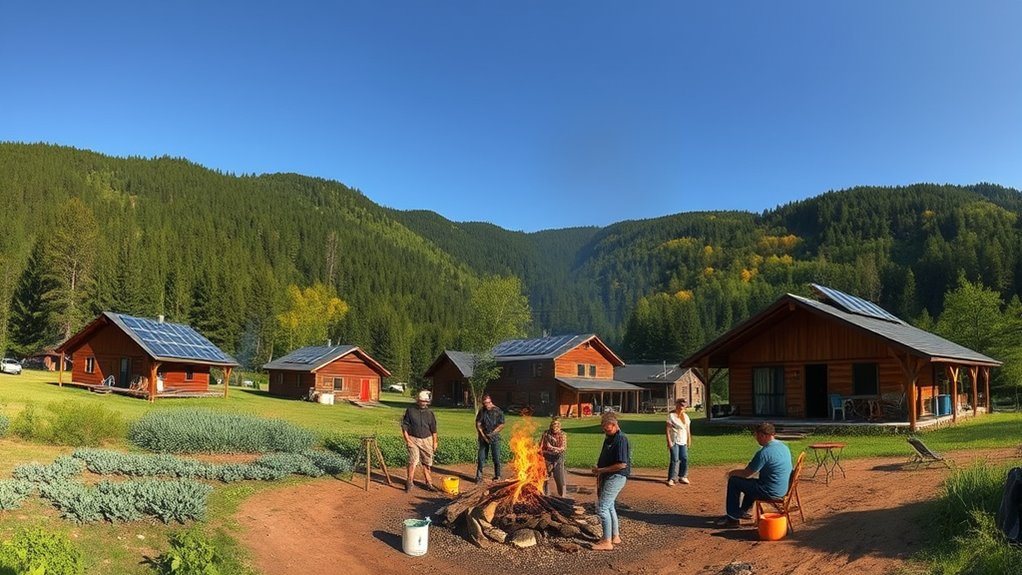
Building a strong community or support network is essential for long-term survival, especially when resources are limited and help may not arrive promptly. By fostering community resilience, you create a system where members share skills, supplies, and knowledge, increasing everyone’s chances of thriving. Mutual aid forms the backbone of this network, allowing you to rely on others during crises and contribute when you can. Establish relationships before an emergency strikes, identifying trustworthy individuals who can provide assistance or expertise. Regular communication and joint planning strengthen bonds and ensure everyone understands their roles. Together, you’ll create a resilient, adaptable support system that enhances survival prospects, mitigates risks, and sustains life off-grid for months or more.
Frequently Asked Questions
How Can I Maintain Mental Health During Long-Term Off-Grid Living?
You can maintain mental health by practicing mindfulness techniques daily, helping you stay grounded and manage stress. Make an effort to engage socially, even if it’s just with neighbors or online communities, to prevent loneliness. Setting routines, staying active, and pursuing hobbies also boost your mental well-being. Remember, maintaining connection and mindfulness keeps your mind sharp and resilient during extended off-grid living.
What Are the Best Methods for Long-Term Off-Grid Financial Sustainability?
Sure, because relying on your secret stash of gold bars and barter systems will keep you rolling in cash, right? The best methods for long-term off-grid financial sustainability include smart investment strategies that grow your resources over time and establishing barter networks with neighbors. These practices help you stay self-sufficient, avoid the bank, and keep your treasure chest full while living off-grid. Who needs a paycheck when you’ve got barter and investments?
How Do I Plan for Unexpected Natural Disasters Off-Grid?
When planning for unexpected natural disasters off-grid, you focus on emergency preparedness and resource diversification. Make sure you have essential supplies like food, water, and medical kits stocked and accessible. Diversify your resources by storing fuel, alternative energy sources, and backup tools. Regularly review and update your disaster plans, ensuring everyone knows their roles. Staying adaptable and prepared helps you respond effectively and sustain your lifestyle during unforeseen events.
What Legal Considerations Should I Be Aware of When Living Off-Grid Long-Term?
When living off-grid long-term, you need to be aware of property rights and zoning regulations. Make certain your land is legally zoned for off-grid living and check for restrictions on structures or resources. You should also understand local laws related to water use, waste disposal, and building codes. Staying compliant helps you avoid legal issues and ensures your off-grid lifestyle remains sustainable and trouble-free.
How Can I Ensure Communication With the Outside World Over Extended Periods?
To stay connected over extended periods, you should invest in reliable communication methods. Satellite communication devices are crucial, as they work independently of cell networks and provide global coverage. Emergency radios are also indispensable; they keep you informed and can alert you during crises. Regularly check and maintain your equipment, and keep spare batteries or power sources nearby to guarantee continuous contact with the outside world.
Conclusion
By carefully planning each step—securing water, growing food, and building a sturdy shelter—you’re setting yourself up for long-term survival. As you establish power, manage waste, and prepare for emergencies, you’ll find that resilience becomes second nature. When you build connections and support networks, unexpected challenges become more manageable. Ultimately, your preparedness creates a rhythm of stability and hope, turning the unpredictable into a manageable, sustainable life off-grid, months or more into the future.






